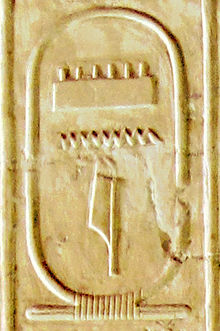メネス
| メネス | |
|---|---|
| Menes | |
 | |
| 古代エジプト ファラオ | |
| 統治期間 | 前3000年頃 - 前2850年頃, |
|
ファラオ名 (五重称号)
| |
メネス(アラビア語: مينا、ギリシア語: Μήνης、[1]、エジプト語:Meni)は、エジプト初期王朝時代のファラオである。上下エジプトを統一し、エジプト第1王朝を創設したとされている[2]。
メネスの実在については、2019年現在でも議論の対象であるが、エジプト学の主流では、歴史学、考古学的な様々な証拠に基づいてメネスを第1王朝の最初のファラオであるナルメルと同一であると見なしている[3][4][5]。
名前と同定
[編集]| Menes ヒエログリフで表示 | |||||||||
|---|---|---|---|---|---|---|---|---|---|
|
メネスという一般的な名前は、プトレマイオス朝時代の歴史家で司祭のマネトの記述に依っている。マネトは Μήνης という表記を用いた[1][6]。一方、ギリシア風の Μιν という表記は紀元前5世紀のギリシアの歴史家ヘロドトスに依るもので[7]、エジプト神話の神ミンとの混同があったものと考えられている[8]。エジプト語の「メニ」は、エジプト第19王朝の頃の『トリノ王名表』や『アビドス王名表』に由来する[6]。
メネスという名前は、「持続した彼」という意味で、I. E. S. Edwards は、「半伝説的な英雄を説明するための単なる形容語句に過ぎず、・・・その名前は失われている。」と指摘している[1]。特定の人物を指しているのではなく、カー、スコーピオン・キング、ナルメル等の初期王朝時代の複数のファラオを集合的に表しているという説もある[1]。
歴史
[編集]古代の伝承によると、メネスは、紀元前3000年と2850年の間に、上下エジプトを1つの王国に統一し、第1王朝を興した人物とされている[6][9] [10]。
しかし彼の名前はカイロ石やパレルモ石のような現存の遺物には残っておらず、エジプト第5王朝期に作られた王名表の石碑にも表れない。彼の名前は後の文献に、ホルスから直接王座を受け継いだ最初の人間のエジプト王として登場する[11]。またさらに後の王名表にも人間の最初の王として記載されている。マネトも彼のことを重要な人物として記述している。メネスは、古代ローマを興したロームルスのように、古代エジプトの多くの歴史を作った人物として描かれている[12]。マネトは、メネスは「軍を前線に率い、偉大な栄光を勝ち取った」と記述している[10]。
首都
[編集]マネトはティニスを第1王朝及び第2王朝の首都とし、メネスはティニス出身であるとしている[10]。一方、ヘロドトスはメネスが干拓堤防を築いてナイル川の流れを変えた後[13]、首都としてメンフィスを建設したと記述している[14]。マネトは、メンフィスの建設はメネスの息子の Athothis によるものとし[10]、メンフィス出身のファラオは第3王朝まで登場しない[15]。
文化への影響
[編集]シケリアのディオドロスは、エジプト神話における神々の戦争を導入し、贅沢な生活様式とともに生け贄の習慣を作ったのはメネスであると記述している[16]。
この後者によって、メネスはエジプト第24王朝のファラオであるテフナクト1世によって名誉を汚されている。プルタルコスは、贅沢の導入者としてメネスに対する呪いの言葉が刻まれたテーベの柱石について言及している[16]。
死去
[編集]マネトによると、メネスの治世は62年間で、カバに殺害された[10][17]。
その他
[編集]ツァーリやカイザーがガイウス・ユリウス・カエサルに由来するように、クレタのミーノースの名がメネスに由来するという説もある[18]。しかし、メネスの名前が古代エジプトの記録に出てこないため、メネスの名前の方がミーノースに由来している可能性もある。
現代文化での言及
[編集]スコットランドの東洋学者で劇作家であるアレクサンダー・ダウは、古代エジプトを舞台とした Sethona という悲劇を書いた。その中で、主役のメネスは「セラピスの次の男性王位後継者」として描かれている。1774年の初演では Samuel Reddish が演じた[19]。
関連項目
[編集]出典
[編集]- ^ a b c d Edwards 1971: 11
- ^ Beck et al. 1999
- ^ Edwards 1971: 13
- ^ Lloyd 1994: 7
- ^ Cervelló-Autuori 2003: 174
- ^ a b c Etheredge 2008
- ^ Herodotus: 2.4.1, 2.99.1ff.
- ^ Lloyd 1994: 6
- ^ Maspero 1903: 331
- ^ a b c d e Verbrugghe and Wickersham 2001: 131
- ^ Shaw and Nicholson 1995: 218
- ^ Manley 1997: 22
- ^ Herodotus: 2.109
- ^ Herodotus: 2.99.4.
- ^ Verbrugghe and Wickersham 2001: 133
- ^ a b Elder 1849: 1040
- ^ Sayce and Gibbon 1906: 15
- ^ R.Wunderlich.The secret of Creta".Efstathiadis group.Athens 1987.p171
- ^ Dow 1774
参考文献
[編集]- Beck, Roger B.; Black, Linda; Krieger, Larry S.; Naylor, Phillip C.; Shabaka, Dahia Ibo (1999). World history: Patterns of interaction. Evanston, Illinois: McDougal Littell. ISBN 0-395-87274-X
- Cervelló-Autuori, Josep (2003). "Narmer, Menes and the seals from Abydos". Egyptology at the dawn of the twenty-first century: proceedings of the Eighth International Congress of Egyptologists, Cairo, 2000 (Report). Vol. 2. Cairo: The American University in Cairo Press..
- Diodorus Siculus (n.d.). Bibliotheca historica. 1
- Dow, Alexander (1774). Sethona: a tragedy, as it is performed at the Theatre Royal in Drury Lane. London: T. Becket
- Edwards, I. E. S. (1971). "The early dynastic period in Egypt". The Cambridge Ancient History (Report). Vol. 1. Cambridge: Cambridge University Press..
- Elder, Edward (1844). “Menes”. In Smith, William. Dictionary of Greek and Roman Biography and Mythology. 2. Boston: Little, Brown and Company.
- Etheredge, Laura (2008). "Menes". Encyclopædia Britannica (Report). Encyclopædia Britannica Online..
- Faber, George Stanley (1816). The origin of pagan idolatry: ascertained from historical testimony and circumstantial evidence. 2. London: Charles Rivington
- Gardiner, Alan (1961). Egypt of the Pharaohs. Oxford: Oxford University Press
- Herodotus (n.d.). The Histories
- Joseph, Frank (2004) [2002]. The destruction of Atlantis: compelling evidence of the sudden fall of the legendary civilization. Rochester, Vermont: Bear & Company. ISBN 1591430194
- Lloyd, Alan B. (1994) [1975]. Herodotus: Book II. Leiden: Brill Publishers. ISBN 9004041796
- Maspero, Gaston (1903). “History of Egypt”. In Sayce, Archibald Henry. History of Egypt, Chaldea, Syria, Babylonia, and Assyria. 9. N.p.: Kessinger Publishing
- Maspero, Gaston; Sayce, Archibald Henry (ed.); McClure, M. L. (trans.) (1910) [1894]. The dawn of civilization: Egypt and Chaldæa. London: Society for Promoting Christian Knowledge. ISBN 9780766177741
- Manley, Bill (1997). The Penguin Historical Atlas of Ancient Egypt. London: Penguin. ISBN 0140513310
- Rachewiltz, Boris de (1969). “Pagan and magic elements in Ezra Pound's works”. In Hesse, Eva. New approaches to Ezra Pound. Berkeley, California: University of California Press.
- Ryholt, Kim (2009). “Egyptian historical literature from the Greco-Roman period”. In Fitzenreiter, Martin. Das Ereignis, Geschichtsschreibung zwischen Vorfall und Befund. London: Golden House Publications.
- Sayce, Archibald Henry; Gibbon, Edward (1906). Ancient Empires of the East. 1. Philadelphia: J. D. Morris. ISBN 0-8109-9096-2
- Shaw, Ian; Nicholson, Paul (1995). The Dictionary of Ancient Egypt. N.p.: Harry N. Abrams, Inc.. ISBN 0-8109-9096-2
- Verbrugghe, Gerald P.; Wickersham, John M. (2001) [1996]. Berossos and Manetho, introduced and translated. Ann Arbor: The University of Michigan Press. ISBN 0472086871
- Waddell, L. A. (1930). Egyptian civilization: Its Sumerian origin. London: n.p.. ISBN 9780766142732


